What Are the Parts to a Navy Officers Dress White Uniform ?
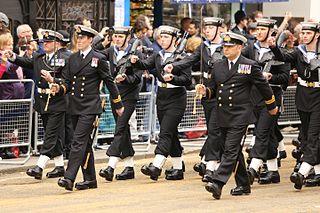
Officers, a Chief Fiddling Officer and Ratings of the Imperial Navy on parade in No. ane dress uniform.
The uniforms of the Royal Navy take evolved gradually since the start uniform regulations for officers were issued in 1748.[1] The predominant colours of Imperial Navy uniforms are navy blue and white. Since reforms in 1997 male and female ratings have worn the same ceremonial uniform.[1]
RN uniforms accept served as the template for many maritime uniforms throughout the earth, peculiarly in the British Empire and Commonwealth. The uniforms of the Royal Naval Reserve, Royal Fleet Auxiliary, the Maritime Volunteer Service, the Ocean Cadet Corps, the Navy branch of the Combined Cadet Force and the Volunteer Cadet Corps likewise as modern uniforms of Trinity House, the Royal Australian Navy, the Royal New Zealand Navy and Imperial Malaysian Navy are almost identical to RN uniforms, with the exception of flashes at shoulder meridian and on rank slides. Royal Canadian Navy uniforms are also very similar, though the traditional sailor suit is no longer used and some distinctly Canadian rank insignia and titles are used; e.g., master sailor.
History [edit]
Officers [edit]

Captain Edward Vernon (1723–1794)
Compatible regulations for officers were commencement issued by Lord Anson in 1748, and remained unchanged for nearly twenty years. Reportedly, the officers themselves advocated its adoption, as they "wished to be recognised as being in the service of the Crown."[two] The "best uniform", consisting of an embroidered blue coat with white facings, worn unbuttoned with white breeches and stockings, was worn for formalism occasions; the "working rig" was a simpler, less embroidered uniform for day-to-day utilise. In 1767 the best uniform was abolished and replaced by the working rig, with a simpler "undress" uniform for day-to-day apply. By 1795, as a result of the French Revolutionary Wars, a obviously blue "undress" coat had been introduced for everyday use, and epaulettes were officially introduced.[i] By 1846, all officers wore epaulettes. The white facings came and went over the years, briefly condign blood-red (1830-1843). Though stripes of lace on the cuffs had been used to distinguish the unlike ranks of admiral since 1795, the first version of electric current rank insignia, consisting of stripes with a "curl" in the height i, was introduced for all officers in 1856.[3]
In 1825, the white breeches were replaced by trousers for officers serving in the Uk, although the practice of wearing white trousers with naval uniforms (popularly known every bit "Wei-Wei Rig") continued for officers serving overseas (due east.g. in the Westward Indies and China) until 1939. Throughout the nineteenth century, there was bully variation in uniform; officers paid for their ain uniform, and often adapted it to fit civilian way of the fourth dimension, as the Admiralty regulations governing compatible were not highly prescriptive.[1]
For service in tropical climates, a white tunic and trousers were introduced in 1877.[i] During Earth War Ii, a blue working wearing apparel on the lines of battledress was approved. Caps were to take white tops all yr around, and blue caps were abolished in 1956.[3]
The distinctive white collar patch of the midshipman first appeared in 1758.[3]
Ratings [edit]
Uniform for ratings was kickoff established past the Admiralty in 1857. Prior to this, most seamen wore "slops", or fix-fabricated clothing sold to the ship's crew past a contractor; many captains established general standards of advent for the seamen on their vessel, but at that place was little or no uniformity between ships. On ane occasion in 1853, the commanding officer of HMSHarlequin paid for his boat crews to dress every bit harlequins, an incident which may have contributed to the Admiralty'south determination to adopt a standard uniform.[i]
A number of changes have been introduced since the introduction of the kickoff rating uniform, notably the removal of the blue jacket in 1890, and the replacement of bell-bottoms by flared trousers in 1977. In 1997 in that location was a major standardisation plan, meaning that all ratings at present clothing the same ceremonial uniform for the first fourth dimension in history.[1]
Present-day uniforms [edit]
Nowadays-day Imperial Navy officers and ratings take several different uniforms; some are blue, others are white.
Officers [edit]
Formalism Mean solar day Dress [edit]

Formalism Day Clothes, every bit worn by Vice-Admiral Sir Adrian Johns
This is worn only by a few senior Officers (Admirals and Admirals of the Fleet, members of the Royal Family or Royal Household of Flag Rank, and the Vice-Admiral of the Uk).[4] In improver, in the past several members of the Purple Family beneath flag rank; virtually notably Charles, Prince of Wales and Andrew, Duke of York wore this compatible whilst holding the ranks of commander and captain. It consists of a navy blue double-breasted tailcoat with standing collar faced white with golden edging, worn with gilded shoulder boards, and gold laced blue trousers. Officers of the rank of Admiral of the Fleet, and as well officers belongings the appointments of Outset Sea Lord, Chief of the Defense force Staff or the Defence Services Secretary (if a naval officer) habiliment a full apparel sword belt embroidered with oak leaves; others wearable a full dress sword belt with three stripes. It is worn at parades such as Lord High Admiral'due south Divisions (BRNC) or at land occasions. Introduced in 1960, it is essentially the same Full Dress uniform worn for formalism occasions before that date only with the cocked hat replaced past the peaked hat and the epaulettes replaced by shoulder boards, and without the gage slash and aureate lace on the rear pockets. The formalism day coats worn by women button up the reverse way, and the tricorn hat is worn instead of the peaked cap (equally worn by the Princess Royal).
No. ane apparel [edit]

This is the formal uniform worn on ceremonial occasions. For all commissioned officers it consists of a double-breasted, navy blue reefer jacket with iv rows of two buttons, matching trousers, white shirt, blackness tie, peaked cap, black socks, and black leather shoes. It is divided into 1A (with medals and bearing artillery), 1B (same equally 1A, simply without arms), and 1C (with medal ribbons). Female personnel may wear skirts except when carrying a sword or rifle. It was originally introduced in 1889 and was initially known as the 'undress coat'.[5]
No. 2 dress [edit]
This mess dress is worn in the evenings for dining. 2A is the formal evening apparel for ceremonial dinners; it consists of a navy blue mess jacket with a white waistcoat (blackness cummerbund for female officers) with miniature medals. For officers of the rank of captain and above, a navy bluish tailcoat (known every bit an 'undress tailcoat') may optionally be worn in lieu of the mess jacket. For officers of these ranks; in addition, gold-laced trousers (known informally as 'lightning conductors') may too exist optionally worn either with the tailcoat or the mess jacket. 2B is "mess undress" for other mess functions, and is worn with either a black cummerbund or navy blue waistcoat and miniature medals. 2C, "red sea rig", is worn for informal evening article of clothing on board ship; information technology consists of a white brusk sleeved shirt, worn with shoulder boards, without medals and with black trousers, blackness shoes and a black cummerbund.[5]
-

No. 2A dress, every bit worn past The Earl of Wessex
-

Blue No. 2B wearing apparel (tailcoat option), as worn past then-Rear-Admiral the Duke of York (right)
No. 3 dress [edit]

3A dress

3C dress
This is worn all yr round for general duties. It consists of a white shirt with rank insignia on the shoulders, and advisable headgear. For officers 3A dress includes a long-sleeved shirt and necktie, while 3B includes a short-sleeved shirt just without the tie. 3C is the same in all respects as 3A but with the add-on of a navy blueish woollen jersey. Shoulder boards may besides be worn with 3C clothes.[5] The beret may be worn with this wearing apparel only on sure occasions.
No. four wearing apparel [edit]

No. 4 RNPCS uniform, as worn by a Warrant Officeholder First Class, Captain, and Primary Petty Officer.
The Royal Navy Personal Wearable System (RNPCS) was adopted navy-wide during 2015 subsequently being tested beginning in 2012. It is similar to the British Regular army'southward Personal Wear Organization Combat Uniform (PCSCU), but in navy blue instead of multi-terrain pattern. It is divided into two categories: Number 4 clothes, which consists of a navy bluish burn-retardant jacket (worn tucked in and with the sleeves rolled up or down as personal preference), navy blue beret, navy blue stable belt, navy blueish fire-retardant trousers, steaming boots, navy blue T-shirt and an optional navy blue microfleece, and Number 4R apparel, which is the same only without the jacket and with an optional baseball cap, to exist worn at sea. The peaked cap or sailor's cap may be worn with this clothes on sure semi-formalism occasions.[6] [seven]
As of 2020, the Royal Navy has been testing a modified blueprint that changes the top from a zippered jacket-like design to a buttoning shirt, with the rank insignia moving back to the shoulder position, and a removable, Velcro-backed name record. The reasoning behind the changes to make the uniform more than comfortable to article of clothing in warmer climates.[viii]
The RNPCS replaced No. 4 Action Working Dress (AWD), which consisted of blue shirt and trousers, both with flame retardant properties, worn with pullover (optional) and cap or beret. Specialist badges are worn on the sleeves; each branch and specialisation has its own insignia and are to be worn accordingly. This is worn by all ranks and rates.
No. 5 dress [edit]
No. 5 refers to the wide range of task-specific working kit worn by different personnel (e.grand. medical, flying deck, boat crews, chefs, defined, etc.) for detail tasks. They are worn as required for duties.[v]
White uniforms [edit]
In the tropics on formal occasions officers vesture a brusque sleeved white bush jacket with an open collar and shoulder boards, matching trousers, peaked cap and white leather shoes. Like temperate number one wearing apparel, it is divided into three categories: 1WA (with medals and when bearing arms), 1WB (with medals but when not bearing arms), and 1WC (with medal ribbons rather than medals and when not begetting arms.)
Officers above the rank of commander, and those property certain appointments, may optionally wear instead a long-sleeved, high-necked white tunic, with five buttons down the front, worn with white trousers and white shoes. Other officers may be instructed to habiliment this uniform "when required to conform with accepted international standards of dress on land or major ceremonial occasions".[5]
In that location is also a white version of No. 2 dress; gilt-laced navy blue trousers may be optionally worn with white No. 2 dress by officers of the rank of captain and above.[5]
White No. three dress is the same equally 3B apparel, but is worn with white trousers, socks, and shoes in place of the black versions normally worn. White number 3B and 3C uniforms have been abolished. They consisted of a white short sleeve shirt and white shorts; 3B was worn with long white socks and white shoes, while 3C was worn with boat shoes. Both white 3B and white 3C dress have been replaced by the new number 4 RNPCS clothes.[v]
-

Admiral Sir George Zambellas wearing No. 1WC White ceremonial clothes (white tunic choice)
-
Admiral Sir George Zambellas (right) in White No. 1WC wearing apparel (bush jacket option)
-
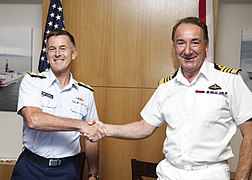
Admiral Sir George Zambellas wearing white No. 3WA dress.
Senior ratings [edit]
No. i wearing apparel [edit]
For senior rates, petty officer and above, No. 1 Dress consists of a double-breasted jacket similar to that worn by deputed officers but with only 6 buttons. Historically, this was originally known equally the 'long jacket', and was first introduced for engine room artificers, masters-at-artillery, and schoolmasters. Later, its employ was extended to all Chief Petty Officers (1879) and Petty Officers (1920). Relevant rate insignia is worn on the left arm of the jacket by piddling officers. Like their counterparts as worn past deputed officers, it is divided into 1A, 1B and 1C dress.[v] In 1A dress, when armed, a white web chugalug and white gaiters are worn by senior ratings every bit they are by junior ratings. WO1s wear a sword and sword belt with 1A clothes. However this differs from that worn by commissioned officers in that it has a blackness grip instead of a white one, and it has a plain stepped pommel instead of the officers' lion mane 1.
-
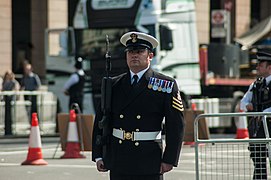
No. 1A dress, as worn by a picayune officer
No. ii clothes [edit]
This mess undress is optional wear in the evenings for dining by all senior rates and warrant officers. It is worn with a black cummerbund and miniature medals. The cutting of the jacket is different from that worn past officers: it is double breasted, but features a shawl collar and merely 4 buttons instead of six. Merchandise badges and other non-noun badges are not worn on the mess jacket, but cuff buttons and substantive rate badges are. This is worn with plain blue mess trousers and (optionally) the peaked cap. Those senior ratings who accept not applied for mess apparel for 2B dress may instead wear 1C dress with a black bow necktie substituted for the black direct necktie.[5]
No. 3 dress [edit]

This is the same every bit the various types of number iii dress every bit worn by commissioned officers. Senior ratings vesture shoulder rank slides with 3A, 3B and 3C only WO1s may optionally wear shoulder boards with 3A and 3C dress.[5]
No. four dress [edit]
Senior ratings currently vesture the No. 4 RNPCS dress.[five]
White uniforms [edit]
These are the same as the white uniforms currently worn by commissioned officers. Like with commissioned officers, a white tunic may be worn with 1AW dress and 1BW dress when "required to adjust with accepted international standards of dress on state or major ceremonial occasions, merely the white tunic worn by senior rates differs from that of commissioned officers in that it only has four buttons rather than five and does non characteristic shoulder boards nor fittings for them. Petty officers clothing blue on white versions of their substantive charge per unit, trade, and good bear badges with the tunic, Main Petty Officers wear their cuff buttons and a gilded on blue trade badge above the correct cuff, and Warrant officers wear gold on white versions of their sleeve rank badges. Medals and rate shoulder badges only are worn with the bush jacket. WO1s may habiliment optional shoulder boards with the bush jacket every bit well. When armed, senior ratings wear white gaiters and white webbing belts, every bit with the blue version.[5]
Junior ratings [edit]
No. 1 dress [edit]

This is the formal uniform worn on ceremonial occasions. For inferior ratings information technology is a traditional navy blueish conform. It is divided into 1A (with medals and begetting artillery), 1B (aforementioned equally 1A, but without artillery), and 1C (with medal ribbons). Female personnel may wearable skirts except when carrying a sword or burglarize.[five] In 1A clothes, when armed, a white spider web belt and white gaiters are worn.
The current uniform for junior ratings dates in its present class from 1906, replacing an earlier version introduced in 1856 that featured an untucked apron instead of the navy bluish seaman's jumper, that was itself based on the traditional (only unregulated) wearing apparel of the seaman.
No. 2 dress [edit]
Mess dress is non worn past junior ratings but 1C wearing apparel is worn instead. 2C, "red sea rig", is worn for informal evening article of clothing on board send.[five] However, the black cummerbund is not worn by junior ratings in this rig.
No. 3 dress [edit]

A Petty Officer (left) and Leading rating (correct) wearing 3A and 3C dress respectively
This is the aforementioned as for Officer's No. 3 dress just with the relevant charge per unit insignia and seaman's cap (or beret). Junior rates are simply issued with brusk-sleeve shirts and are not issued with ties. Thus No.3 wearing apparel is divided into 3B (without jersey) and 3C apparel (navy blue jersey worn over the shirt with the shirt neckband out). There is no equivalent of 3A apparel for junior ratings.
No. four dress [edit]
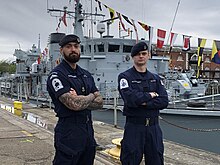
Ratings wearing RNPCS Uniform
Inferior ratings, in common with all ranks and rates of the Royal Navy, are currently issued the new No. 4 RNPCS uniform.[5]
No. five dress [edit]
No. v is the collective category for all specialist working uniforms. They are worn every bit required for duties. These include overalls, dry out and wet suits, concrete training uniform, and dental and medical scrubs. Included in this category equally well is the Multi-Terrain Design (MTP) PCS (personal clothing system) uniform.
White uniforms [edit]
For junior ratings, the white warm climate No. one wearing apparel is a white version of the traditional sailor's accommodate. The white warm climate versions of No. 2 and No. three dress are the aforementioned for the counterparts worn past officers and senior rates. Nonetheless, only short-sleeved shirts are issued and worn and ties are not worn by junior ratings in these rigs.
-

1AW wearing apparel, as worn past three leading ratings.
Defunct uniforms [edit]
Full Dress [edit]
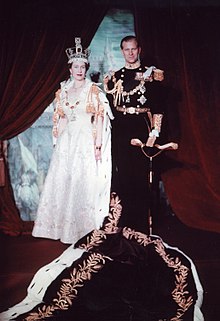
Introduced in its ultimate grade in 1827, but had steadily evolved from the undress uniform introduced in 1748; this uniform was worn past all commissioned officers from sub-lieutenant upwards, as well every bit warrant officers. Information technology consisted of a blueish double-breasted tailcoat with viii gold buttons worn with blueish trousers with gold lace down the side, bicorn hat, sword belt and sword with scabbard, and gold epaulettes (gold 'scales' were worn by sub-lieutenants and neither epaulettes nor scales were worn by warrant officers). It was placed 'in abeyance' (i.e. not used but not abolished) in January 1916 until the end of the First World War. It was restricted between the world wars to court levees. On all other ceremonial occasions, Apron Coat (with epaulettes) was prescribed. In July 1930, officers of the rank of commander and above were required to provide themselves with Total Dress.
It was again declared in abeyance with the outbreak of war in 1939, simply was not formally abolished. Used on several formalism occasions after the war (such every bit the coronation of Elizabeth Ii), it was replaced in 1960 with the current Formalism Day Dress. A version of Royal Navy Full Dress, consummate with epaulettes and cocked lid, is still worn by the Lord Warden of the Cinque Ports, merely the current incumbent (Lord Boyce) wears his Royal Navy ceremonial day coat in lieu of this. Information technology was last worn past Sir Robert Menzies during his tenure every bit Lord Warden from 1966 to 1978.
Round jacket [edit]
Colloquially known as 'the jacket', this was originally a more than practical 'working' version of the full dress glaze that was improvised by officers cut off the tails of a spare undress coat. This do was already informally widespread amongst officers at body of water only in the 1825 regulations, the circular jacket was finally given official sanction. It was only worn at sea, and was worn with either a peaked cap or a round (similar to a top) hat. It was abolished for all commissioned officers in 1891, simply cadets and midshipmen still wore it for formal occasions until it was finally abolished for them in 1951.
Frock Coat Dress [edit]

Frock Glaze Dress (without epaulettes), worn by Captain the Prince of Wales, later King Edward Eight, in 1931.
This was introduced in 1847 and was divided into several categories: Frock Coat with epaulettes; which was worn with the bicorn hat and medals, Frock Coat without epaulettes, which was worn with the peaked cap. It became official 'working dress' in 1858. It was altered in 1933 by having merely four buttons (instead of five) each side, three of which were to exist buttoned. This enabled longer lapels to be incorporated, reflecting civilian fashions of the fourth dimension. Frock Coat Dress was (similar Full Wearing apparel) placed in abeyance and 'landed' in 1939, and although not formally abolished was not worn until it was finally abolished in 1949. A modified version of this uniform is still worn; normally with peaked cap and without epaulettes, past the Main and Elder Brethren of Trinity House.
Battledress [edit]
This was not introduced until insufficiently late in World War II, in dissimilarity to its Army and RAF equivalents. From 1941, Army battledress was approved for use by Majestic Navy personnel until 1943, when a Navy Blue version of battledress was introduced to be used only by the Regal Navy. Battledress stock from WW2 was still existence worn at BRNC Dartmouth past Officers under Grooming (OUTs – now known as cadets or YOs – Young Officers) until the belatedly 1980s. It was used equally a formal ceremonial compatible until those officers received their bespoke tailored outfits towards the end of training.
Others [edit]
-

Royal Navy Lieutenant wearing the former No. 4 AWD dress.
See as well [edit]
- British Armed Forces uniforms
- British Army uniform
- History of the Royal Navy
- Royal Air Force uniform
- Royal Navy officeholder rank insignia
- Purple Navy ratings rank insignia
- Uniforms of the Royal Marines
- The Royal Hospital School
References [edit]
- ^ a b c d e f g National Archive page for naval uniforms
- ^ Rank and Mode, National Maritime Museum
- ^ a b c 'The Dress of Naval Officers', National Maritime Museum, 1966
- ^ RN clothes regulations 2014, annex 39b
- ^ a b c d e f one thousand h i j k l m n o "Addendum 39A RN Dress Tables" (PDF). October 2017. Retrieved 4 February 2019.
- ^ Whitehead, Tom (18 March 2012). "New Royal Navy uniforms to involve baseball caps and Velcro". The Daily Telegraph. London. Retrieved 2012-03-24 .
- ^ Malik, Shiv (18 March 2012). "Navy crew trial first new-look uniform in twenty years". The Guardian. London.
- ^ "RNPCS Upgades - a Freedom of Information request to Royal Navy" (PDF). five June 2020.
Further reading [edit]
- Miller, Amy (2007) Dressed to Kill: British Naval Compatible, Masculinity and Contemporary Fashions, 1748–1857. National Maritime Museum, London. ISBN 978-0-948065-74-3.
- Chapter 38 – Policy and Appearance (PDF). Royal Navy Volume of Reference 3. Feb 2013.
- BR 3 Annexe 39A - Majestic Navy dress tables (with photos)
- BR 3 Annexe 39E - Naval Officers and Ratings: Illustrations of RN and QARNNS Badges of Rank, Rate and Other Insignia
Source: https://en.wikipedia.org/wiki/Uniforms_of_the_Royal_Navy

0 Response to "What Are the Parts to a Navy Officers Dress White Uniform ?"
Post a Comment